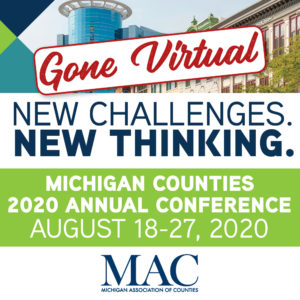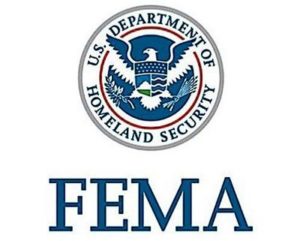Virtual Annual Conference begins on Tuesday
 The first events of MAC’s two-week Virtual Annual Conference are set for Tuesday, Aug. 18, including a Plenary Session of special reports from MAC personnel.
The first events of MAC’s two-week Virtual Annual Conference are set for Tuesday, Aug. 18, including a Plenary Session of special reports from MAC personnel.
Week one of the conference, which runs Aug. 18-27, also will include the President’s Gathering with conference keynoter Tom Izzo of the MSU Spartans (Aug. 20).
Registered attendees will be receiving emails today (Aug. 14) with their access credentials for all of the digital events, including the regional caucuses to elect Board members and the Annual Business Meeting to approve policy platforms. Just a reminder: Only county commissioners may participate in the regional caucuses and Annual Business Meeting.
The conference program will be posted to MAC’s conferences website page for reference during the event. Recordings of the conference workshops and special sessions will be posted to the website, too, but not until September.
Federal FAQ sheet has key details on FEMA matching rules
 The U.S. Treasury has updated its Coronavirus Relief Fund (CRF) FAQ document. Main items they updated are:
The U.S. Treasury has updated its Coronavirus Relief Fund (CRF) FAQ document. Main items they updated are:
- Additional clarification on using CRF dollars for the non-federal FEMA matching requirement: Specifically, the guidance states that states and counties are fully permitted to use payments from the CRF to satisfy 100 percent of their cost share for lost wages assistance recently made available under the Stafford Act.
- Clarification on incurred costs and grant programs: The guidance states that a grant made to cover interest and principal costs of a loan, including interest and principal due after the period March 1, 2020, to Dec. 30, 2020, will be considered an “incurred cost” during the covered period.
For more resources from the federal and state governments on COVID response, visit MAC’s Resources Page.
Michigan Treasury holds sixth webinar on COVID-related funds
 The hazard pay program, the payroll reimbursement program and the August revenue sharing payment were among topics addressed by officials with the Michigan Treasury during a webinar Wednesday co-sponsored by MAC and other local government groups.
The hazard pay program, the payroll reimbursement program and the August revenue sharing payment were among topics addressed by officials with the Michigan Treasury during a webinar Wednesday co-sponsored by MAC and other local government groups.
The session was the sixth in an ongoing series to brief local governments on pandemic-related expenses, programs and reimbursements.
Although Treasury does not anticipate utilizing all of the allocated $100 million for the hazard pay program, the department does anticipate expending the entire $200 million in the first round of the payroll reimbursement program that covers public safety and public health payroll expenses for April and May 2020.
To get CARES funds from the state to compensate for the terminated August revenue sharing payment, counties will have to certify to Treasury their desire to receive these funds and to allocate them to COVID-related expenses – including additional months of public safety and public health payroll expenses. Under the authorizing legislation, counties will get roughly 150 percent of their August revenue sharing in additional CARES funds. Those funds should go out in early September.
The Department also spent time this week going over the necessary accounting procedures in order to accurately and appropriately allocate the funding.
To watch the recording of the webinar, follow this link.
For more information on this issue, contact Deena Bosworth at bosworth@micounties.org.
Whitmer vetoes health facility immunity provisions
 An extension of legal immunity to certain health facilities, including Medical Care Facilities (MCFs) was vetoed by Gov. Gretchen Whitmer.
An extension of legal immunity to certain health facilities, including Medical Care Facilities (MCFs) was vetoed by Gov. Gretchen Whitmer.
The immunity would have applied to civil or criminal liability during a state of disaster or state of emergency declaration under Senate Bill 899, by Sen. Mike MacDonald (R-Macomb County).
Per the governor’s veto letter: “If this bill only attempted to restore the protections I offered under my orders, I would consider signing it. But the bill goes much further in ways that are directly counter to the interests of those receiving care. For example, this bill would give health care providers and the facilities that employ them broad immunity every time an emergency or disaster is declared, regardless of whether the circumstances demand this extreme measure.”
House Speaker Lee Chatfield (R-Emmet) said in a statement that the state’s “health care heroes” are working on the frontlines in difficult decisions and “deserve to know we all have their back.”
“It’s strange that the governor felt our frontline health care workers deserved this protection two months ago but not today, since she did not include any legitimate explanation of her veto,” he said. “But I know my commitment to doctors, nurses and hospitals has not changed. The House of Representatives will continue to look for ways to partner with them, support them, and help them combat this pandemic.”
Also this week, the governor extended the Executive Order titled “Enhanced protections for residents and staff of long-term care facilities during the COVID-19 pandemic,” through Sept. 7.
For more information on this issue, contact Meghann Keit at keit@micounties.org.
Commission accepting public input on indigency standard
 The Michigan Indigent Defense Commission (MIDC) is accepting comments to a proposed standard for determining indigency and contribution, as required by statute. The MIDC Act requires the commission to “promulgate objective standards for indigent criminal defense systems to determine whether a defendant is indigent or partially indigent” and to “determine the amount a partially indigent defendant must contribute to his or her defense.”
The Michigan Indigent Defense Commission (MIDC) is accepting comments to a proposed standard for determining indigency and contribution, as required by statute. The MIDC Act requires the commission to “promulgate objective standards for indigent criminal defense systems to determine whether a defendant is indigent or partially indigent” and to “determine the amount a partially indigent defendant must contribute to his or her defense.”
Under 2018 statutory changes, the Legislature required systems to make “a preliminary inquiry regarding, and the determination of, the indigency of any defendant, including a determination regarding whether a defendant is partially indigent.” However, to ensure that systems do not vary dramatically in their determinations, the Legislature also tasked the commission with providing standards for systems to follow.
The proposed indigency standard can be found here.
“Written public comment for consideration by the Commission should be submitted before Sept. 14, 2020, to LARA-MIDC-Info@michigan.gov. Alternatively, comments can be sent by that date to the MIDC Office, 200 N. Washington Square, 3rd Floor, Lansing, MI 48913. All comments will be posted and available on the MIDC website.”
The MIDC will hold its next meeting on Aug. 18 at 9 a.m. via Zoom to continue review of FY21 compliance plans and costs analyses. Meeting agenda information and zoom links can be found here.
For more information on this issue, contact Meghann Keit at Keit@micounties.org.
Get state advice on pension/OPEB issues
 The Michigan Treasury will brief local governments on the management and sustainability of their pension and retiree health care (OPEB) systems during a webinar on Tuesday, Aug. 18 at 2 p.m.
The Michigan Treasury will brief local governments on the management and sustainability of their pension and retiree health care (OPEB) systems during a webinar on Tuesday, Aug. 18 at 2 p.m.
Topics will include updates from the Municipal Employees Retirement System (MERS) and the Michigan Association of Public Employees Retirement Systems (MAPERS) on local pension and health care systems, problem solving and management of legacy debt from MSU Extension, University of Michigan, and the Citizens Research Council, and an update regarding reporting data, waiver applications, and the corrective action process for Public Act 202 of 2017 from the Department of Treasury.
Participants can register on the webinar’s registration page.
NACo analyzes executive actions taken by president
 On Aug. 8, President Trump released a series of administrative actions — an executive order and three memorandums — to address the expiration of federal unemployment benefits and provide other assistance for U.S. residents hurt by the COVID-19 pandemic. The actions taken by the administration do not address NACo’s main priority for COVID relief, which is additional flexible fiscal aid for state and local governments of all sizes.
On Aug. 8, President Trump released a series of administrative actions — an executive order and three memorandums — to address the expiration of federal unemployment benefits and provide other assistance for U.S. residents hurt by the COVID-19 pandemic. The actions taken by the administration do not address NACo’s main priority for COVID relief, which is additional flexible fiscal aid for state and local governments of all sizes.
Here is a quick summary of two of the key areas for counties:
Unemployment Insurance (UI)
- Extra federal UI benefit on top of states’ regular UI benefit would be reduced from $600 to $400 per week
- Of the $400 total,
- WH proposes that $300 would be funded through FEMA’s existing Disaster Relief Funds (DRF)
- WH proposes to earmark up to $44 billion of $70 billion in existing DRF dollars – which would last for about 5 weeks at current UI levels
- States would be responsible for the 25% FEMA DRF state match, or $100 per UI recipient each week
- Governor must submit a federal request to FEMA to receive the extra federal UI payments; It is not automatic!
- WH notes that states may use their Treasury Coronavirus Relief Fund (CRF) dollars for the $100 state match; U.S. Dept of Labor issued a memo indicating that administration might also waive the $100 / 25% match for states
- However, the National Governors Association notes that states have already obligated more than 75% of CRF dollars so unlikely that states have enough money for the state match from Treasury CARES Act
Payroll taxes for Social Security and Medicare
- WH memo only applies to employee share that is normally collected and submitted by employers (and employee side of self employed)
- Earlier COVID19 supplemental law already allowed postponement for employer share of payroll taxes
- Explain that payroll taxes consist of:
- Social Security at 12.4% (6.2% by employee and 6.2% by employer) (NOTE – believe self employed pay the full 12.4%)
- Medicare at 2.9% (1.45% by employee and 1.45% by employer)
- WH action would only delay/postpone collection of employee share of payroll taxes, similar to earlier congressional action for employers. Money would still be owed to the federal government!
For additional detail, visit NACo’s blog.
 Staff picks
Staff picks
- Shoreline-mapping EGLE drone sent to watery Lake Michigan grave by U.P. bald eagle (Department of Environment, Great Lakes and Energy)
- Michigan plans dedicated road lanes for autonomous vehicles (ClickonDetroit.com)
- Outline of the Michigan Tax System (Citizens Research Council of Michigan)
- There’s a shortage of Dr. Pepper during the coronavirus pandemic (Today.com)
